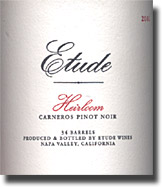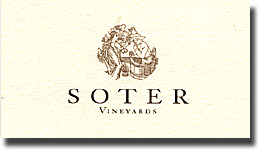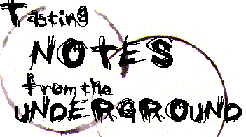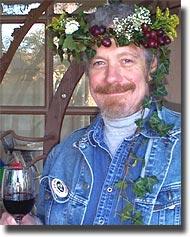|

Part 1 | Part 2
GoP: We finally got our first taste of the Heirloom Pinot Noir just
last Friday, and it's a massive wine. I felt that it was anywhere from 5
- 10 years from optimum drinking. What kind of aging potential do you
think it has?
 Soter:
Well, the Heirloom is a whole story unto itself. To your
specific question about its drinkability, I think it is made for the
long term; it's made in the old - world style, with no apologies for
early drinkability, or the lack of. It's made with tannin and grip and
lots of new oak that really does demand a little cellaring. When it
comes to market, it's already a year older than the Carneros blend that
we make, and that suggests its reserve quality, because it takes longer
for it to evolve; it's longer in the barrel, it's longer in the bottle,
it should be longer in your cellar. It would almost disappoint me if it
didn't have a ten - plus year life span, and that is really exceptional
for American Pinot Noir. Soter:
Well, the Heirloom is a whole story unto itself. To your
specific question about its drinkability, I think it is made for the
long term; it's made in the old - world style, with no apologies for
early drinkability, or the lack of. It's made with tannin and grip and
lots of new oak that really does demand a little cellaring. When it
comes to market, it's already a year older than the Carneros blend that
we make, and that suggests its reserve quality, because it takes longer
for it to evolve; it's longer in the barrel, it's longer in the bottle,
it should be longer in your cellar. It would almost disappoint me if it
didn't have a ten - plus year life span, and that is really exceptional
for American Pinot Noir.
It's rooted in the development of the great raw material that it comes
from. Much like heirloom vegetables that we see in the marketplace, a
real awakening of the plant diversity that's available to us that we
were in danger of losing sight of, Pinot Noir and other grape varieties
have a similar amount of plant diversity, but universities and the
commercial nurseries tend to conspire against us experiencing that kind
of diversity. So one of the ways to get around that is to actually go to
great vineyards in Burgundy or wherever you might find good Pinot Noir
growing and take cuttings yourself and propagate them yourself, because
the Heirloom wine is dedicated to the proposition of preserving plant
diversity in rare plant material, and all of these selections are not
available through commercial sources. We have to propagate them
ourselves, and they would not pass muster under so - called commercial
standards. That's not to say they're sub - standard; in fact, we rate
them on the great quality of wine that they make, but universities and
nurseries that might need to certify them find that they often don't
pass, because they don't yield enough, or because they have minor flaws,
these cosmetic diseases that make them theoretically uncertifiable.
They're fully suitable for making wine, but unfortunately, they have
chronically low crops of what we call "shot" berries that are
imperfectly fertilized berries that are extra small, and it's precisely
that extra small berry that gives that extra dimension of skin - to -
juice ratio, and therefore a higher level of concentration of tannins
and color in the wine. And there's that grip and that demanding of the
age - worthiness of the wine that really comes from the raw material.
"These clones are sometimes referred
to as 'Samsonite' clones, or 'suitcase' clones..."
Another tangible benefit of the association with Beringer - Blass is
that, to date, I've only been able to source these heirloom selections
from very small plots here and there as we find them in growers'
vineyards or experimental plots. But, with this last spring, we have
dedicated a seven - acre parcel to ten different selections of heirloom
Pinot Noir, so the heirloom wine will have its own home in a vineyard
that will be a kind of little library for these heirloom selections.
GoP: Where did you get the selections for this vineyard?
Soter: Well, over nearly twenty years of prowling California for
good selections of Pinot Noir, we've slowly come to realize where some
of these standout selections are, and we've done a slow process of
propagating them, and making the cuttings available for this new parcel
that we're doing.
GoP: So these are like the things that Andre Tchelistcheff and Joe
Swan brought back from Burgundy?
Soter: Yes, precisely. We call those guys our smuggling
ancestors. (Laughter.) These clones are sometimes referred to as "Samsonite"
clones, or "suitcase" clones, and they have a habit of being sewn in
coat linings; it's not like it's contraband, but it IS also the way that
California contracted phyloxera disease by the free importation and
exportation of plant material, and that's how Europe got it too, so
there are legitimate reasons why one would want to be careful about
trading plant material. But in fact, it's a precious opportunity to
explore the plant diversity of some of these.
GoP: One thing I noticed about the '01 Heirloom is that it seemed to
be just a little hot; it's listed at 14.5% alcohol, after all. Is that
something that's going to even out over time?
Soter: That would be variable a little bit for a couple of
reasons. One, vintage to vintage, the alcohol might vary by a half a
percentage, so it is a full bodied wine, and does rely on that full
measure of alcohol to give you that extra weight. But this might be a
useful point for all your readers to keep in mind, that when you're
serving big, new world reds, it's important to watch the temperature of
their service. If the sample came to you out of somebody's car, and had
been warming up for a while, it would be a far way off from cellar
temperature. Room temperature isn't the right way to serve wine, because
often, that's a lot warmer than cellar temperature, and cellar
temperature is the proper temperature to serve red wine. With high
alcohol reds, as soon as the temperature gets over 70 degrees, you'll
start to sense the alcohol coming to a somewhat out - of - balance
proportion. With that and a few more years of aging, I think that's
going to harmonize quite well.
GoP: Let's talk about Soter Vineyards, your Willamette
Valley project. How did that come about?
 Soter:
Soter Vineyards
is a small family project that was started in 1997, many years before we
made the partnership with Beringer - Blass and Etude. It was a vision of
my wife and I, who were both raised in Oregon; even though I've made my
living and my profession in California viticulture, I've been a fan of
Oregon wines for some time, but never made the leap to making them. But
I've been fascinated by the great quality of Oregon Pinot Noirs over the
years, and followed many of the producers there, and consider several of
them as benchmark producers. In the old days, the Eyrie Vineyard and
Ponzi, and these days, Ken Wright are making just stellar wines that
really are world class in the way they perform. I'm such a fan of Pinot
Noir that I would probably love to make it on three continents, if I
could figure how to be in all those places at once or in the right
season. But I am fascinated by the expression of the grape wherever it's
grown, and just as I am in love with the lush candied fruit qualities of
California Pinot Noirs, I find the Oregon wines to have a completely
different expression, beautiful blackberry and blueberry notes, and a
structure that's more akin to the European wines from Burgundy, and for
good reason, because the Oregon wine country is in a more temperate
region at higher latitudes, and it shares a lot of similarities with
Burgundy, and I think it shows in the wines. Soter:
Soter Vineyards
is a small family project that was started in 1997, many years before we
made the partnership with Beringer - Blass and Etude. It was a vision of
my wife and I, who were both raised in Oregon; even though I've made my
living and my profession in California viticulture, I've been a fan of
Oregon wines for some time, but never made the leap to making them. But
I've been fascinated by the great quality of Oregon Pinot Noirs over the
years, and followed many of the producers there, and consider several of
them as benchmark producers. In the old days, the Eyrie Vineyard and
Ponzi, and these days, Ken Wright are making just stellar wines that
really are world class in the way they perform. I'm such a fan of Pinot
Noir that I would probably love to make it on three continents, if I
could figure how to be in all those places at once or in the right
season. But I am fascinated by the expression of the grape wherever it's
grown, and just as I am in love with the lush candied fruit qualities of
California Pinot Noirs, I find the Oregon wines to have a completely
different expression, beautiful blackberry and blueberry notes, and a
structure that's more akin to the European wines from Burgundy, and for
good reason, because the Oregon wine country is in a more temperate
region at higher latitudes, and it shares a lot of similarities with
Burgundy, and I think it shows in the wines.
We have a twenty acre vineyard on a forty acre parcel; it's southwest of
Portland, and takes about forty five minutes to drive there, so it's
about thirty miles as the crow flies.
GoP: Is that in the Salem area?
Soter: Not quite as far as Salem, it's near McMinnville. The
little towns are called Carlton and Yamhill; Yamhill is the little
village that the county takes its name from. We call the vineyard Beacon
Hill, and we make two wines, a Pinot Noir of course, and the production
level is about 1,500 cases per year. We also make a
brut rose styled sparkling wine made from Chardonnay and Pinot Noir.
It's kind of a soap - box wine for me, and a project of love, because
it's dedicated to my wife, who is a real fan of Champagne; I told her
I'd make one from our own property, and she's the inspiration for it. I
also said that if we couldn't sell it, she'd have to drink it all,
because we'd have a lifetime supply!
Luckily, people like Charlie Trotter
and
Madeline Triffon are very fond
of the product, and they're happily pouring it and introducing it to
customers. That is made in very small quantities, about 500 cases a
year. Quite unusual for a sparkling wine, I border on saying that it's
robust; it has a lot of weight and dimension, it's all barrel aged, and
has a seriousness, and complexity and dimension that is rarely found in
what is too often forgettable fizz that is OK for aperitifs. But this
wine really is a wine first, and sparkling thereafter, and it shows at
best at the table, because it has a good range of compatibility with
foods. I can sit down and have just that with a great salmon dinner.
GoP: Where are the wines made?
Soter: They are made in a small converted barn, which is a very
humble edifice recently refurbished by shoveling out a lot of cow
manure. We ferment in very small batches, everything is hand done, the
sparkling wine is all hand - riddled and disgorged and the wine is
stored in a small hillside cave that is adjacent to the old cow barn.
All in, the two products are about 2,000 cases a year, with the
possibility of having only about 2,500 cases a year. It's a small
project that's really dedicated to the next generation; I hope my kids
will take advantage of our setting this up and moving on. I really
believe that wine businesses should be generational, and we're all so
new to the business in America, we're just hoping it survives.
GoP: What's your national distribution?
Soter: It's fairly limited, as you can imagine; with just 2,000
cases, it isn't going to get very far. But it will be in the major
cities in the country, New York and south Florida, Chicago, Detroit,
Seattle, Dallas, Houston, Denver, San Francisco and Los Angeles.
At that point, Tony had to leave for another appointment, so I thanked
him for his time and bid him and his entourage adieu. He is
obviously passionate and totally focused on his life's work; he was very
gracious, willing to answer whatever questions I had to ask and most articulate in his
explanations and descriptions of the various aspects of Etude and Soter
Vineyards that we discussed. It was a pleasure to spend a little time
talking with a man who has played such an important role in making some of the
finest wines to ever come out of California, and we're looking forward
to following the progress of his Heirloom Pinot Noir and Soter Vineyards
projects. Based on past performance, these should be yet two more
success stories in Tony Soter's marvelous career.
Reporting from Day-twah,
Bastardo
|





